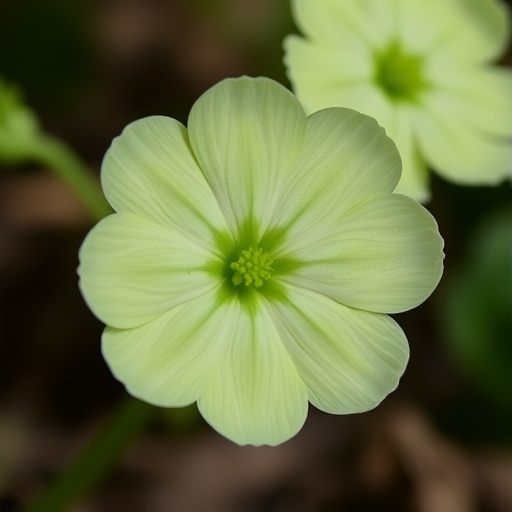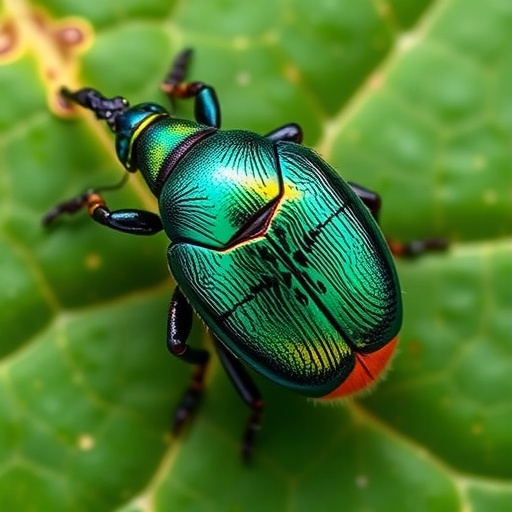
In a groundbreaking study published in the journal Biochemical Genetics, researchers led by Kadam et al. investigate the chloroplast genome of Stellaria media, commonly known as chickweed. This plant, often overlooked in botanical circles, has now garnered the attention of scientists due to its complex genetic makeup and its significance for understanding evolutionary processes. The chloroplast genome, which plays a crucial role in photosynthesis and energy production, serves as a vital lens for examining plant taxonomy, phylogenetics, and evolutionary biology.
Chloroplasts, the organelles responsible for photosynthesis in plants, contain their own DNA, separate from the nuclear genome. This unique feature allows researchers to trace evolutionary lineages and understand genetic variations amongst species. Kadam and colleagues embarked on this research journey to unravel the secrets held within the chloroplast genome of Stellaria media, knowing that this information may contribute significantly to the broader understanding of plant evolution. Their investigation focused on sequencing, analyzing, and comparing the chloroplast genome sequence with those of other species.
One of the primary objectives of the study was to conduct a comprehensive analysis of the chloroplast genome structure. The researchers employed advanced sequencing technologies to decode the genetic material. By utilizing cutting-edge bioinformatics tools, they were able to accurately assess the size, structure, and gene content of the chloroplast genome in Stellaria media. This detailed analysis revealed not only the presence of expected genes related to photosynthesis but also some unexpected sequences that could indicate novel functions.
Moreover, the findings from this research have significant taxonomic implications. The taxonomic classification of plants has often relied on morphological characteristics that can be misleading or insufficient for discerning evolutionary relationships. The genomic data obtained from Stellaria media provide a more objective basis for classification, which could potentially refine existing taxonomic frameworks within the Caryophyllaceae family. As a widely distributed species, understanding Stellaria media’s chloroplast genome opens new avenues for identifying related species and understanding their evolutionary connections.
In addition to taxonomic implications, the study also highlights the evolutionary perspectives gained from examining the chloroplast genome. The researchers discovered several gene transfer events between the chloroplast and nuclear genomes, which could offer insights into the evolutionary mechanisms that drive adaptation and diversification in plants. The presence of adaptive genes suggests that Stellaria media has undergone extensive evolutionary changes, making it a model organism for studying evolutionary dynamics.
Another fascinating aspect of this research is the exploration of genetic diversity within Stellaria media populations. Through comparative analysis with other closely related species, Kadam and his team were able to chart the genetic variations that exist among different populations. This genetic diversity is crucial for the long-term survival of species as it contributes to their ability to adapt to changing environmental conditions. The implications of these findings extend beyond the lab, touching on conservation efforts and strategies to preserve biodiversity.
Also noteworthy is the potential application of this genetic information in agriculture and horticulture. As farmers and gardeners increasingly seek sustainable practices, understanding the genetics of plants like Stellaria media could inform breeding programs to enhance traits such as resistance to pests or environmental stressors. The study opens doors for biotechnological innovations, possibly leading to crops that can withstand extreme weather events or require fewer resources to grow.
This research does not exist in a vacuum. It builds on a growing body of literature that connects genomics with evolutionary biology. Previous studies have established the relevance of chloroplast genomics in plant phylogenetics and evolutionary studies, and the work of Kadam and colleagues adds another vital piece to the puzzle. By focusing on a species often dismissed as a mere weed, they challenge conventional notions of what plants are worthy of scientific inquiry and underscore the importance of even the most unassuming flora.
Furthermore, the meticulous nature of the study demonstrates the potential of collaborative research efforts. By combining expertise from various fields—including genomics, bioinformatics, and evolutionary biology—the team was able to produce superior results. The interdisciplinary approach is vital in tackling complex biological questions that cannot be answered through a single lens, showcasing how different scientific domains can synergistically enhance our understanding of nature.
As the researchers continue to delve deeper into the chloroplast genomes of other species, they seek to expand their findings beyond Stellaria media. The methodologies and insights gained from this study will pave the way for investigating other plants’ chloroplast genomes, potentially fostering a renaissance in plant genomics. For anyone interested in evolutionary biology, botany, or genetics, this research serves as a compelling reminder of the intricate connections between genes, species, and the environments they inhabit.
The implications of the research from Kadam et al. extend into educational realms as well. By emphasizing the importance of plants like Stellaria media, they highlight the need for increased interest and investment in botany education. Understanding plant genetics and their evolutionary significance could inspire future generations of scientists to pursue careers in this vital field, ensuring a continued exploration of biodiversity and ecological integrity.
In conclusion, Kadam and colleagues’ research on the chloroplast genome of Stellaria media not only enriches our understanding of plant evolution but also sets the stage for future investigations into the complex relationships between plants and their environments. This study represents a significant step forward in our quest to comprehend the dazzling diversity of life on Earth through a genomic lens. The findings of this research will undoubtedly resonate within the scientific community, sparking interest and dialogue that could propel further studies and conservation efforts for years to come.
Subject of Research: Chloroplast Genome of Stellaria media
Article Title: Unraveling the Chloroplast Genome of Stellaria media: Comprehensive Analysis, Taxonomic Implications, and Evolutionary Perspectives
Article References:
Kadam, S.K., Tamboli, A.S., Youn, JS. et al. Unraveling the Chloroplast Genome of Stellaria media: Comprehensive Analysis, Taxonomic Implications, and Evolutionary Perspectives.
Biochem Genet (2025). https://doi.org/10.1007/s10528-025-11229-6
Image Credits: AI Generated
DOI:
Keywords: Chloroplast Genome, Stellaria media, Plant Evolution, Taxonomic Implications, Genetic Diversity, Biotechnology, Conservation, Genomics.
Tags: advanced bioinformatics in geneticschickweed genetic researchchloroplast DNA significancechloroplast genome sequencing techniquesgenetic variations in plantsgroundbreaking genetic discoveries in botanyphotosynthesis organelles DNAphylogenetics and plant taxonomyplant evolutionary biology studyplant genomic analysis methodsStellaria media chloroplast genomestudying plant evolutionary processes




